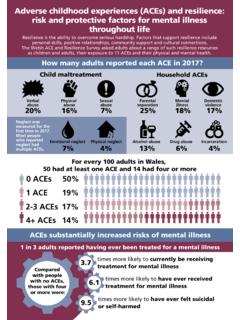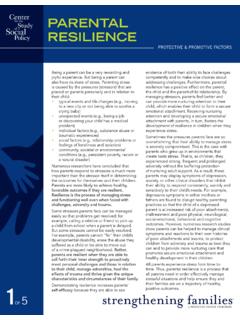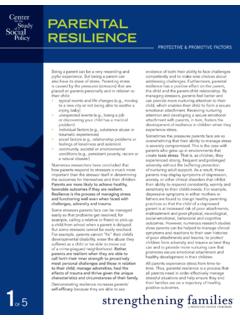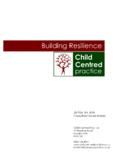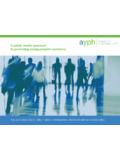Transcription of Promoting Resilience: A Review of Effective …
1 Abc 1 Promoting resilience : A Review of Effective strategies for Child Care Services - Summary Author: Dr. Tony Newman, Barnardo's Research and Development Prepared for the Centre for Evidence-Based Social Services, University of Exeter Date: 2002 Introduction Key Points resilience is a quality that helps individuals or communities resist and recover from adversities. Over the past few decades, children's psycho-social health has declined in all developed countries. Child welfare services have become more pre-occupied with risk factors than with factors which keep children healthy and safe.
2 At present, our understanding of the processes that promote resilience is more extensive that our range of practical applications About this report This report was commissioned by the Centre for Evidence- Based Social Services at the University of Exeter. The purpose of the report is to Review strategies , interventions and approaches that can help promote resilience in children and young people. The report addresses the following questions: What is resilience and why is it important to child welfare services?
3 Why do some children and young people resist and overcome stressful episodes while others suffer long term damage? How can child welfare services promote resilience ? Why is the subject of resilience important to children and to child welfare services? Why is the subject of resilience important to children and to child welfare services? It has been argued that, compared with earlier generations, children are less able to cope with stressors and obstacles, partly because of their being sheltered from challenging opportunities (Mental Health Foundation 1999).
4 Recent trends in health and social care services have tended to emphasise factors that pose risks for children, rather than those which provide opportunities for growth and adaptation (Early and GlenMaye 2000). For example, the percentage of MEDLINE abstracts -the world's largest data base of health care research -containing both the words 'child' and 'risk', has increased from under 1% in the years 1996-70, to almost 16% in 1996-2000 (search conducted 18/01/02 ). abc 2 There is no doubt that the identification of potential risk factors has led to substantial improvements in many areas of children's physical health.
5 However, it has not always led to similar improvements in many aspects of children's emotional and psychological well-being. On the contrary, a substantial increase in psycho-social disorders of children has taken place in most developed countries over the past half century, including suicide and para-suicide, self-injurious behaviour, conduct and eating disorders and depression. (Smith and Rutter 1995; Slap 2001). Even countries with such widely admired social welfare systems as Sweden have not escaped these trends (Nordberg 1994, cited in Werner and Johnson 1999).
6 The dilemma for child care services can be illustrated by the recent rise in the numbers of accidental drownings of children, a trend that has been associated with the over- protection of children by parents, and the corresponding failure of children to be offered sufficient opportunities to learn the management of risk. Over-protection may reduce morbidity, but a hidden price may be paid by children in industrialised countries 'whose lives and childhoods are being newly circumscribed by unprecedented levels of parental concern' (UNICEF 2001:21).
7 Children themselves have also reported increases in poor health. For example, in the UK between 1975 -1998, the proportion of children aged 5-15 years reporting a longstanding illness doubled (Office for National Statistics 2000). The importance of identifying protective as well as risk factors is recognised in the Department of Health Framework for the Assessment of Children in Need and their Families (2000), which contains a very helpful summary of key resilience Promoting factors and their implications for the assessment process (paragraphs to , available on line at www.)
8 Uk/subichildren/content/practiceguide/se ction ). We thus have a worrying situation where children are seemingly being affected by an absolute increase in many serious problem areas, accompanied by an apparent weakening in their capacity for natural resistance. The promotion of resilience may be an important strategy in attempting to reverse this trend, through placing more emphasis on factors that promote well-being, and not just on the identification and elimination of risk (Rayner and Montague 2000). Report structure The definitions of resilience used, search strategy, inclusion and exclusion criteria and method of synthesising the literature are described in this section.
9 The theories underpinning the concept of resilience , their empirical base, and their relevance to child welfare services are summarised in chapter 3. Chapters 4-6 describe interventions and strategies that show promise in terms of Promoting resilience . In order to forge clear links with current national child care strategies the chapters address, respectively, the objectives associated with: Sure Start ( ) -birth to four years. The Children's Fund (www .cypu .gov. uk/corporate/childrensfund) -five to 13 years.
10 Connexions ( ) -13 years upwards. Chapter 7 provides some concluding remarks, and assesses the strengths and weaknesses of resilience theory. A comprehensive bibliography is provided, plus a list of websites where additional information and links can be located. Hyperlinks can be made from the on-line version of this report to these and other sites, which can be found at abc 3 Definitions of resilience resilience is broadly understood as positive adaptation in circumstances where difficulties -personal, familial or environmental -are so extreme that we would expect a person's cognitive or functional abilities to be impaired (Rutter 1985; Garmezy 1985; 1983; 1991; Masten and Coatsworth 1998).










